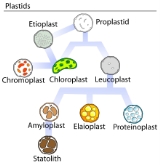
Elaioplast
Encyclopedia

Leucoplast
Leucoplasts are a category of plastid and as such are organelles found in plant cells. They are non-pigmented, in contrast to other plastids such as the chloroplast....
that is specialized for the storage of lipids in plants. Elaioplasts house oil body deposits as rounded plastoglobuli, which are essentially fat
Fat
Fats consist of a wide group of compounds that are generally soluble in organic solvents and generally insoluble in water. Chemically, fats are triglycerides, triesters of glycerol and any of several fatty acids. Fats may be either solid or liquid at room temperature, depending on their structure...
droplets.
Being a variety of leucoplast, elaioplasts are non-pigmented and fall into the much broader organelle
Organelle
In cell biology, an organelle is a specialized subunit within a cell that has a specific function, and is usually separately enclosed within its own lipid bilayer....
category of plant
Plant
Plants are living organisms belonging to the kingdom Plantae. Precise definitions of the kingdom vary, but as the term is used here, plants include familiar organisms such as trees, flowers, herbs, bushes, grasses, vines, ferns, mosses, and green algae. The group is also called green plants or...
plastid
Plastid
Plastids are major organelles found in the cells of plants and algae. Plastids are the site of manufacture and storage of important chemical compounds used by the cell...
s. A different example of a storage-specialized leucoplast is the amyloplast
Amyloplast
Amyloplasts are non-pigmented organelles found in some plant cells. They are responsible for the synthesis and storage of starch granules, through the polymerization of glucose. Amyloplasts also convert this starch back into sugar when the plant needs energy...
.
Compare
- PlastidPlastidPlastids are major organelles found in the cells of plants and algae. Plastids are the site of manufacture and storage of important chemical compounds used by the cell...
- ChloroplastChloroplastChloroplasts are organelles found in plant cells and other eukaryotic organisms that conduct photosynthesis. Chloroplasts capture light energy to conserve free energy in the form of ATP and reduce NADP to NADPH through a complex set of processes called photosynthesis.Chloroplasts are green...
and etioplastEtioplastEtioplasts are chloroplasts that have not been exposed to light. They are usually found in flowering plants grown in the dark. If a plant is kept out of light for several days, its normal chloroplasts will actually convert into etioplasts. Etioplasts lack active pigment and can technically be... - ChromoplastChromoplastChromoplasts are plastids responsible for pigment synthesis and storage. They, like all other plastids , are organelles found in specific photosynthetic eukaryotic species....
- LeucoplastLeucoplastLeucoplasts are a category of plastid and as such are organelles found in plant cells. They are non-pigmented, in contrast to other plastids such as the chloroplast....
- AmyloplastAmyloplastAmyloplasts are non-pigmented organelles found in some plant cells. They are responsible for the synthesis and storage of starch granules, through the polymerization of glucose. Amyloplasts also convert this starch back into sugar when the plant needs energy...
- ProteinoplastProteinoplastProteinoplasts are specialized organelles found only in plant cells. They contain crystalline bodies of protein and can be the sites of enzyme activity involving those proteins. Proteinoplasts are found in many seeds, such as brazil nuts and peanuts...
- Amyloplast
- Chloroplast

